Little Millet or Millets in general are versatile, low carb option for rice and is grown in hardy regions, which makes them ecologically sustainable too. At home, we have been using millets extensively in Dosa / Idli / Uttapam/ Upma/ Pongal / Kichdi./ Bakes etc and we hardly miss the rice in any of these dishes.
Little Millet dosa is a no-rice Dosa / Indian Crepe made with unpolished Little Millets and Lentils. It makes for a filling, Fluten Free vegan Breakfast or brunch option and is served with Chutney / Sambhar etc. Today, I have served it with Chettinad Tomato Chutney and Masala Dosa Potato Filling.
Little Millet dosa is a no-rice Dosa / Indian Crepe made with unpolished Little Millets and Lentils. It makes for a filling, Gluten Free vegan Breakfast or brunch option and is served with Chutney / Sambhar etc
A little more about Little Millet and its benefits
Little millet, scientifically known as Panicum sumatrense, is a small, drought-tolerant grain crop that is grown primarily in India, Africa, and Southeast Asia. It has gained popularity in recent years due to its various health benefits and nutritional value.
Here are some of the names by which little millet is referred to in different parts of India: Kutki (कुटकी) in Hindi, Samai (சாமை) in Tamil, Sama (सामा) – In Marathi and Konkani, Chama (ചമ) – In Malayalam, Gajro (ગઝરો) – In Gujarat,
Kodo (कोदो) in MP and Chattisgarh, Korralu (కొర్రలు) – In Telugu-speaking regions, Vari (वरी) – In Marathi, it is also sometimes referred to as “Vari.”
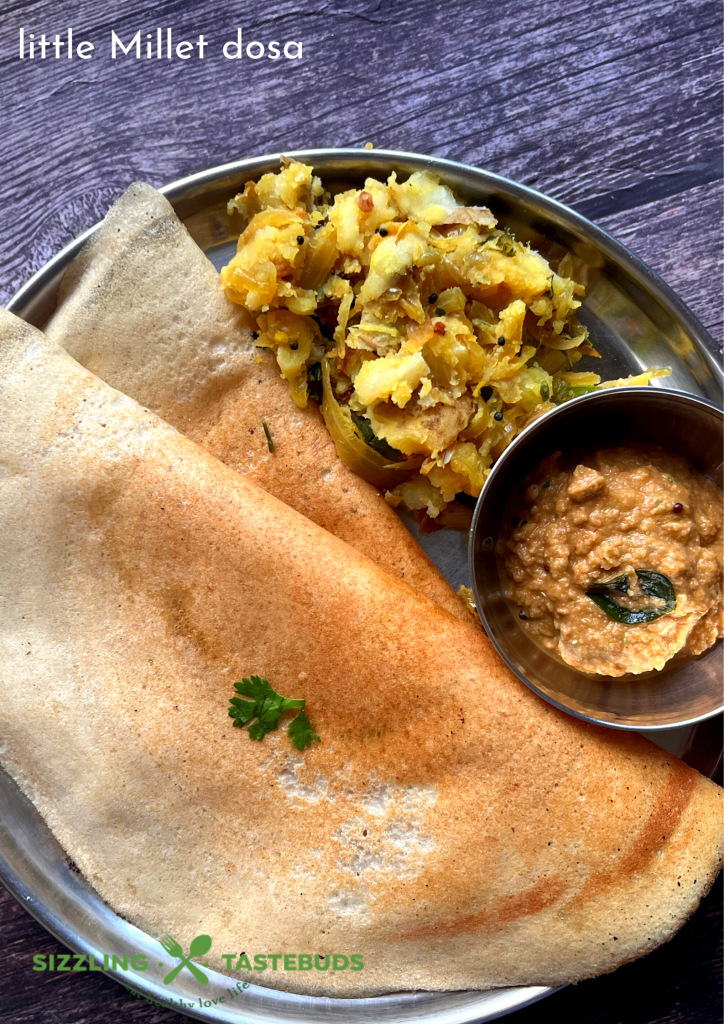
Here are some of the benefits of little millet:
Nutrient-Rich: Little millet is a good source of essential nutrients such as protein, dietary fiber, vitamins (especially B-complex vitamins like niacin and riboflavin), and minerals (iron, calcium, phosphorus, and magnesium). It is particularly rich in calcium, making it a suitable option for those looking to boost their calcium intake.
Low Glycemic Index: Little millet has a low glycemic index (GI), which means it releases glucose into the bloodstream slowly. This can help in managing blood sugar levels and is beneficial for people with diabetes.
Gluten-Free: Little millet is naturally gluten-free, making it an excellent choice for individuals with celiac disease or those who are sensitive to gluten.
High in Antioxidants: Like other millets, little millet contains antioxidants, which can help protect the body from oxidative stress and reduce the risk of chronic diseases.
Weight Management: The dietary fiber in little millet helps promote a feeling of fullness, which can aid in weight management by reducing overall calorie intake.
Heart Health: Little millet is low in saturated fat and cholesterol, making it heart-friendly. It can help in reducing the risk of cardiovascular diseases when incorporated into a balanced diet.
Digestive Health: The fiber in little millet promotes healthy digestion and can help prevent constipation.
Bone Health: Little millet is a good source of calcium and magnesium, which are essential for maintaining strong bones and teeth.
Rich in Protein: It contains a reasonable amount of protein, which is important for muscle maintenance and overall growth.
Easy to Cook: Little millet is easy to cook and can be used in a variety of dishes, including porridge, upma, dosa, idli, and more.
Sustainable Crop: Little millet is a hardy, drought-resistant crop that requires less water and minimal care compared to some other grains. This makes it a sustainable and environmentally friendly crop choice.
Versatile Ingredient: It can be used in both sweet and savory dishes, making it a versatile ingredient in the kitchen.
Supports Local Agriculture: By incorporating little millet into your diet, you can support local agriculture and contribute to the preservation of traditional crops.
It’s important to note that while little millet offers these health benefits, a balanced diet that includes a variety of grains, vegetables, fruits, and other foods is essential for overall nutrition. Little millet can be a valuable addition to your diet, especially if you are looking to diversify your grain choices and enjoy its unique nutritional profile. When had in moderation (as with rice too), millets keep us full for longer and satiates our tummies well. Let’s see how to make this Little Millet Dosa.
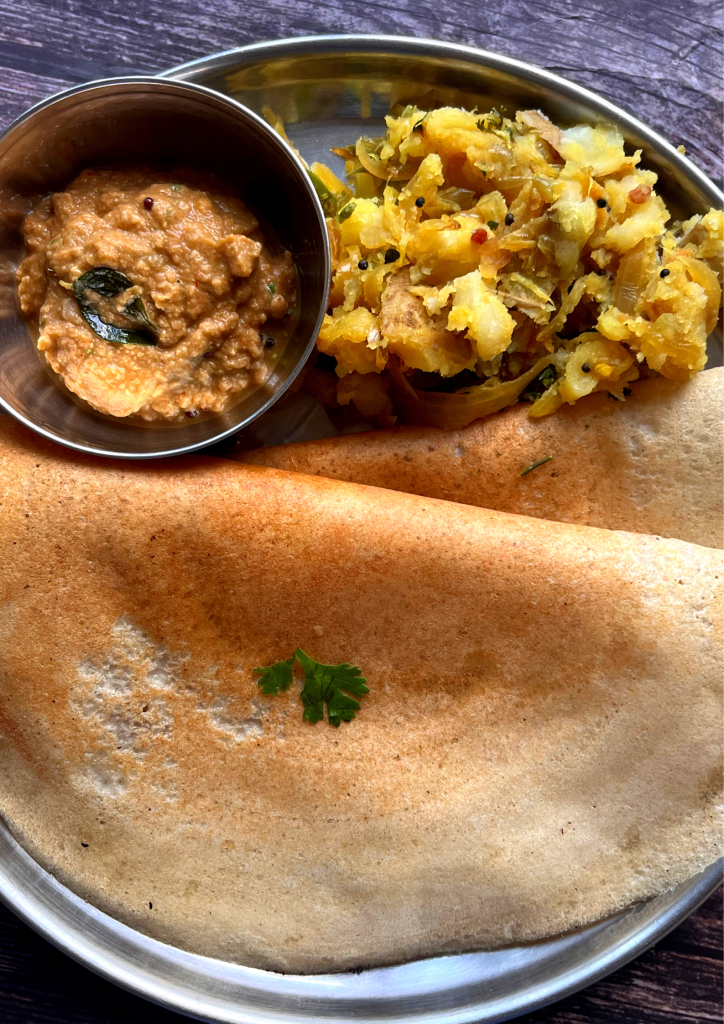
Other Millet based dishes you may like on the blog include:

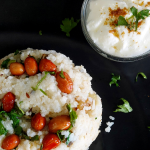

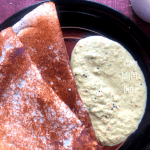
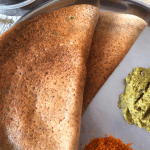
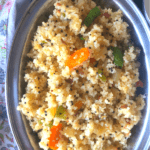
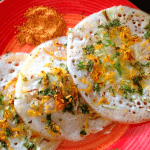
Prep time – 10 mins, Soaking + Grinding time – 8 hours ; Fermentation time – 10+ hours or overnight
Makes – 25 Dosas
Cuisine – South Indian. Course – Breakfast / Light Dinner / Brunch
Served with any Chutney / Sambhar / Curry
What you need to make Little Millet dosa / Samai Dosa
- Little Millet (Sama / Samai/Samae Akki) – 3 cups (1 cup = 100 grams)
- Split Black gram ( Urad dal / Ulundhu) – 1 cup (100 grams)
- 1.5 tsp Salt
- 1 tsp Fenugreek seeds (Methi seeds / Vendhayam)
- 1 tsp Oil – to make dosa (or as required)
PIN FOR LATER
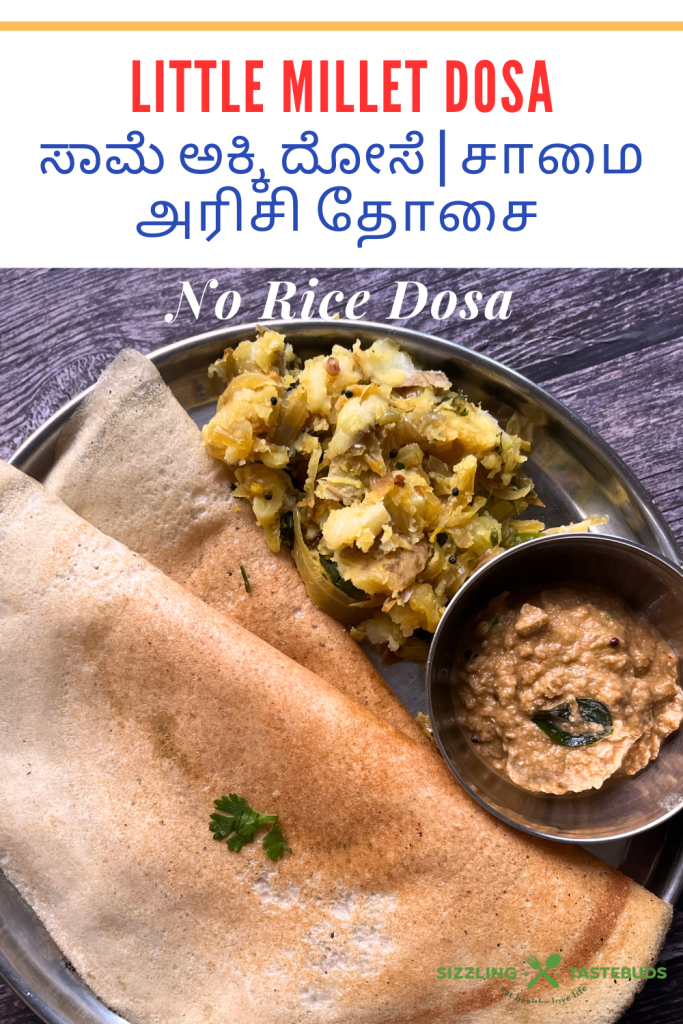
How to make Samai Dosai / Little Millet Dosa
- Wash the Brown top Little millet / Samai in 5-6 turns of water till the muddy water turns clear. Add 1 inch of water above the millets in a large soaking bowl. Soak for 6 hours
- Similarly wash and soak the Urad dal with the methi seeds for 6 hours with 1 inch water.
- After 6-8 hours, grind the urad dal to a smooth butter like consistency.
- Drain the water from the millets and grind this too to a smooth batter.
- Mix both the batters well in a large bowl and add salt.
- Mix throughly. Cover and ferment overnight.
- The next morning, gently mix the fermented batter.
- Unlike Idli or Normal Rice based dosa batters, millet batters don’t rise a lot.
- Heat an iron skillet / non stick tava.
- Add 1-2 tsp of water if needed to bring the batter to a pouring consistency
- Spread a ladle or two of the batter to a thin dosa.
- Drizzle oil / ghee around the dosa, let it cook crisp on one side.
- Simply flip for 5 seconds and serve this Samai Dosai with Sambhar or chutney
- The remaining batter can be refrigerated for upto 5 days.
- With the remaining batter, thick uttapam with onions / tomatoes can be made as a variant with the remaining batter
- Always remember to bring the refrigerated batter to room temperature before making dosa / idli.
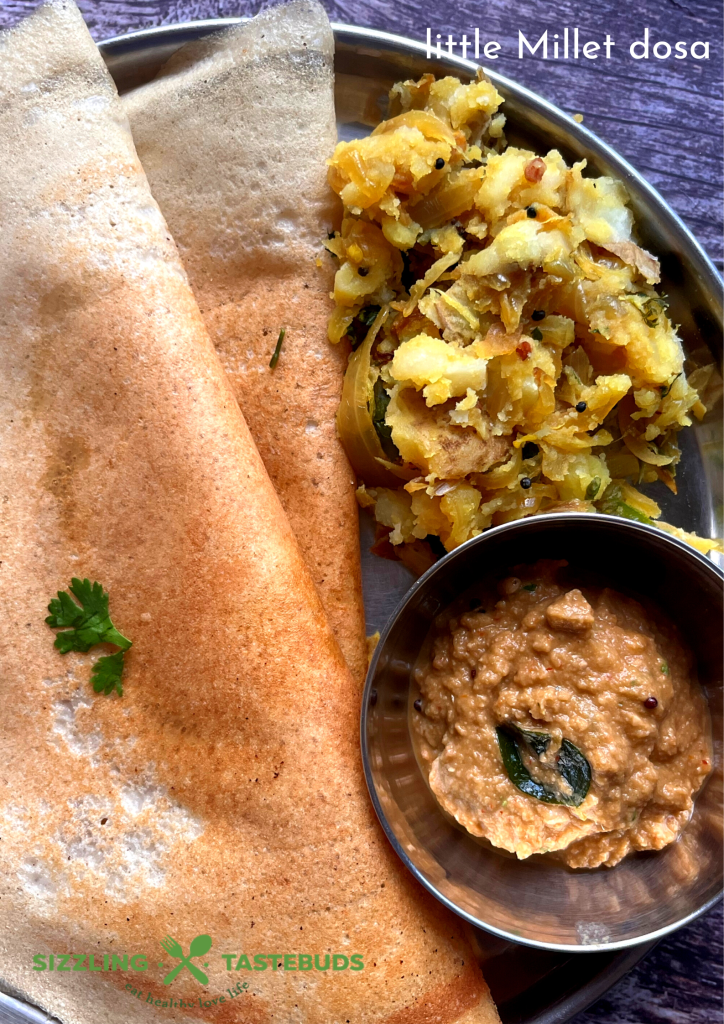
Liked this recipe? SIGN UP FOR THE Sizzling Tastebuds Newsletter (No Spam, Promise!) for fresh, healthy and tasty recipes right into your inbox. Please consider leaving a star ???? rating on this recipe to encourage us . Do FOLLOW Sizzling Tastebuds ON Facebook, Twitter, Pinterest AND Instagram for fresh content, latest recipes and much more!
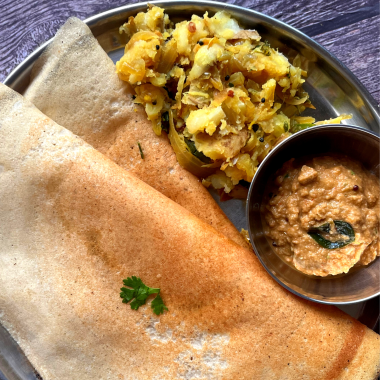
Samai Dosai | Little Millet Dosa | No Rice Dosa
Equipment
- Bowl
- Ladle
- Wet Blender
- Tava / Skillet
- Spatula
Ingredients
- 3 cups Little Millet Sama / Samai/Samae Akki
- 1 cup Split Black gram Urad dal / Ulundhu
- 1.5 tsp Salt
- 1 tsp Fenugreek seeds Methi seeds / Vendhayam
- 1 tsp Oil to make dosa , or as required per dosa
Instructions
- Wash the Brown top Little millet / Samai in 5-6 turns of water till the muddy water turns clear. Add 1 inch of water above the millets in a large soaking bowl. Soak for 6 hours
- Similarly wash and soak the Urad dal with the methi seeds for 6 hours with 1 inch water.
- After 6-8 hours, grind the urad dal to a smooth butter like consistency.
- Drain the water from the millets and grind this too to a smooth batter.
- Mix both the batters well in a large bowl and add salt.
- Mix throughly. Cover and ferment overnight.
- The next morning, gently mix the fermented batter.
- Unlike Idli or Normal Rice based dosa batters, millet batters don’t rise a lot.
- Heat an iron skillet / non stick tava.
- Add 1-2 tsp of water if needed to bring the batter to a pouring consistency
- Spread a ladle or two of the batter to a thin dosa.
- Drizzle oil / ghee around the dosa, let it cook crisp on one side.
- Simply flip for 5 seconds and serve this Samai Dosai with Sambhar or chutney
- The remaining batter can be refrigerated for upto 5 days.
- With the remaining batter, thick uttapam with onions / tomatoes can be made as a variant with the remaining batter
- Always remember to bring the refrigerated batter to room temperature before making dosa / idli.

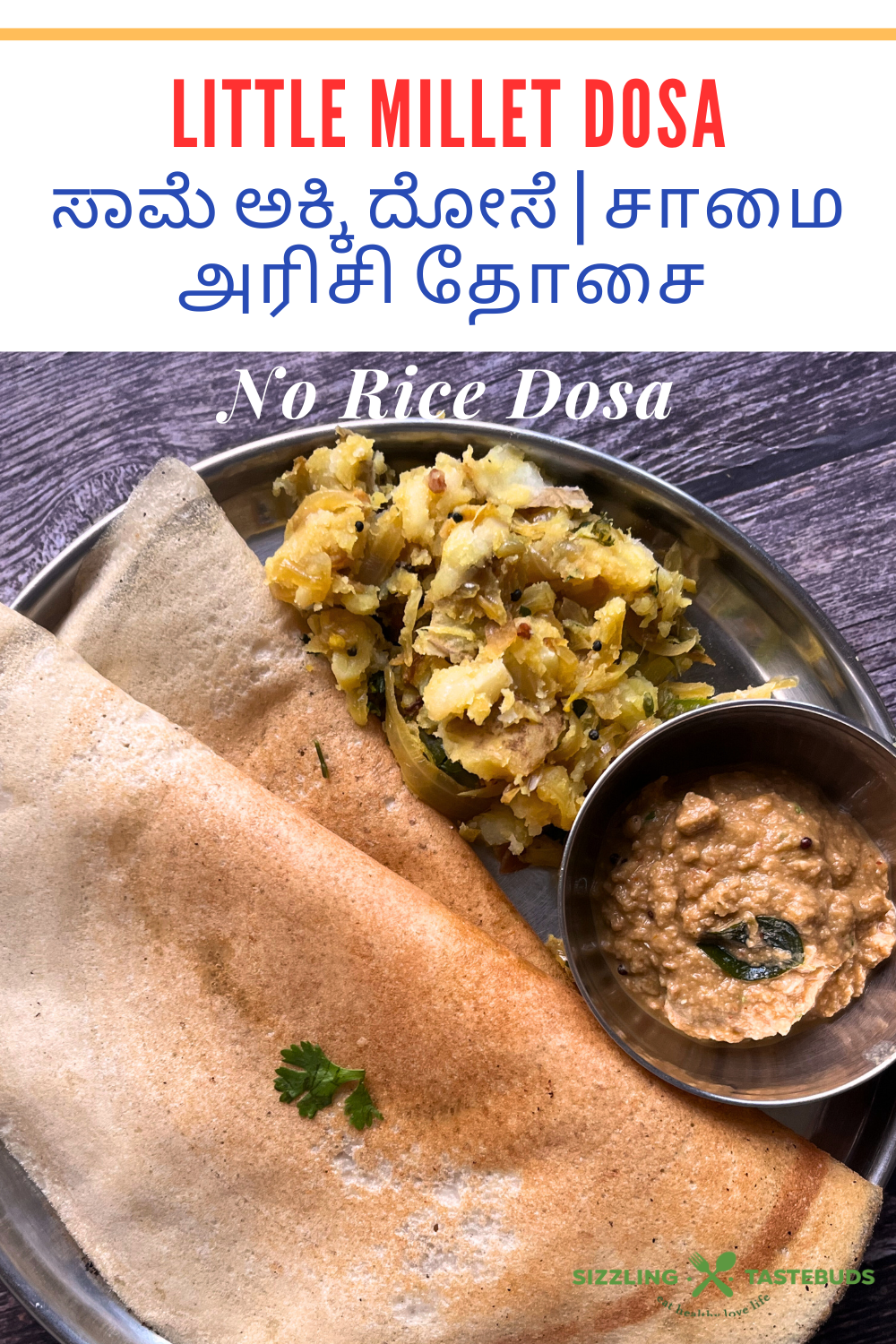

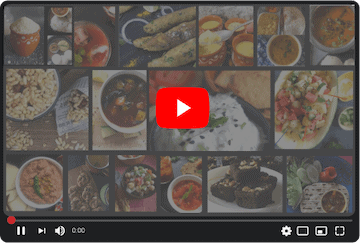



I have been on the lookout for dosa without rice and found your amaing recipe. Millet dosa turned out so crispy and delicious. Thank you for sharing.
Thanks so much for trying this out, Pavani! So glad you liked it
Like this recipe so much. This year have planned to include more millets and healthy pseudo cereals in the diet. And this recipe of samai dosai is perfect.
THanks Mayuri. Hope you do like it when you make it soon
Mmm! these are definitely the best dosas we have eaten in some time. Absolultely loved them and now hubby has asked me to make only these little millets dosa and not the regular ones. Thanks a lot.
Thanks much, Archana
I like the crispy texture of the samai dosa. Will definitely include millet dosa on our menu. My family likes crispy dosas, and this addition will be a welcome. You have explained the procedure in a very crystal-clear manner.
Thanks Neha. DO try it with Little millet
Last few months I am trying to avoid rice in dosa and tried various proportions with millets and other grains. Your dal and millets proportions were spot on and dosa came out perfect!!!
Thank you so much for trying this, Usha ! Glad you liked it…
Love Millet idly/dosa, and it is a regular at home now. An easy way to up the nutrient content of our staple breakfast. And look at that gorgeous color on the dosas. Brilliant recipe kalyani!
Thank you Priya. Yes, this particular dosai with any millet comes out so well, we too are replacing rice big time in idli/dosa with millets..
This is such a perfect dosai recipe without rice. The dosai turns out very crisp and love how easy it is to make as well. Can I use other millet as well similarly?
Thanks Sandhya. Absolulely, Any millet can be subbed for little millet here.
What a fantastic recipe Kalyani! loved this one and such a boon when one is looking for healthy breakfast options…We have also been using different millets in our cooking these days and this recipe has become a good addon to the list!
so good to know, Valli. thank you
Love how you are sharing millet recipes that can be easily incorporated in our daily diet. Very nice Kalyani. Love all your millet recipes.
Thanks so much, Vidhya. Happy to share !
I love adding. illets to idli and dosa batter too.I lov ethe color of your dosas. This is an inviting and healthy plate!
yay ! millets FTW, right?